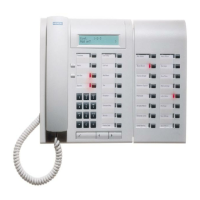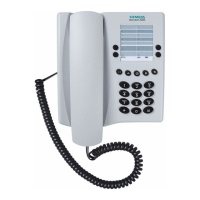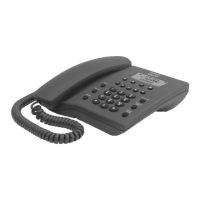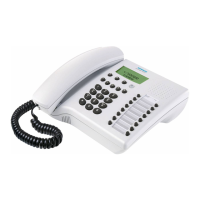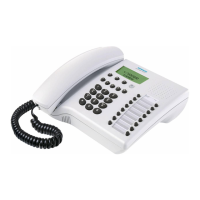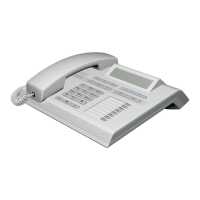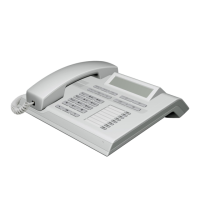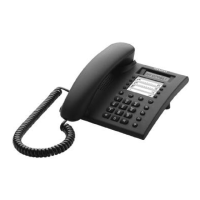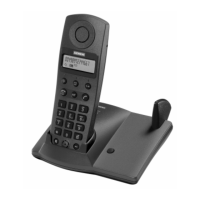Do you have a question about the Siemens 300 Series and is the answer not in the manual?
Overview of ROLMphone 300 and 600 series telephones and their basic features.
Details on ROLMphone 300 series models, including feature keys and display capabilities.
Information on ROLMphone 600 series models, features, speakerphone, and display options.
Explanation of modular options like DCO, HRO, EHO, AAO, and KEO for ROLMphone 600.
Explanation of fundamental phone components: faceplate, line keys, keypad, and display.
Basic steps for making and answering calls on the ROLMphone.
Procedures for initiating calls, including obtaining dial tone.
Methods for responding to incoming calls.
Ways to end a call using the handset or speaker.
How to make calls to extensions within the telephone system.
Steps for making calls to outside numbers, including trunk access.
How to use the telephone's speaker for calls or voicemail.
Operating the two-way speakerphone for making and answering calls.
Information on one-way voice transmission and volume adjustment.
How to turn off the speakerphone microphone during calls.
Feature allowing nearby listening to a conversation via speaker.
How to temporarily place a call on hold and reconnect.
Procedures for transferring calls to other extensions or operators.
Using the Connect key to manage calls on hold or transferred.
Receiving, answering, and leaving messages in the phone's mailbox.
How to select a different ring tone for the telephone.
Joining an existing call on a shared line appearance for a conference.
Breaking into a busy extension for high-priority internal calls.
Waiting on a line for a busy extension to become free.
Requesting a callback when an extension is busy or unavailable.
Setting up multi-party conversations, including outside lines.
Talking privately with a second party while the first is on hold.
Monitoring extension status and automatically dialing or answering.
Choosing a specific trunk (outside line) for placing calls.
Features for signaling other telephones or making group calls.
Signaling another telephone's speaker with a special tone.
Calling group members using short codes instead of extensions.
Making two-way speaker calls within a community group.
Leaving a message for a called party to return your call.
Making announcements over the company's loudspeaker system.
Setting up keys for one-touch dialing of numbers or features.
Saving and redialing the last dialed number.
Making calls directly to another phone's speaker.
Making a one-way call to a designated speaker target.
Making a one-way call to another phone's speaker.
Making one-way calls to multiple speakers simultaneously.
Making a two-way call to another phone's speaker.
Temporarily blocking incoming speaker calls.
Assigning frequently used dialing sequences to single-digit codes.
Dialing frequently called numbers using system-wide codes.
Completing calls when all trunks are busy.
Getting a callback when a trunk becomes free for an outside call.
Waiting on the line for a trunk to become free.
Signals for waiting messages, PhoneMail, and ROLMfax notifications.
How display phones show waiting messages and notifications.
Using dialing numbers to display specific message types.
How non-display phones indicate waiting messages.
Answering calls ringing, on hold, or queued at other extensions.
Answering calls for extensions within a defined pickup group.
Answering calls at a specific extension when the number is known.
Answering incoming calls to the company operator when off duty.
Automatically redirecting incoming calls to another extension or number.
Setting up calls to be forwarded to up to two extensions based on conditions.
Specifying a single forwarding target and conditions from the phone.
Advanced forwarding features like Follow-Me and Forced Forwarding.
Changing forwarding targets from another internal telephone using a PIN.
Immediately forwarding a ringing call by pressing the Forward key.
Forwarding calls sequentially through multiple extensions.
User behavior when receiving forwarded calls.
Moving a call to an extension temporarily without ringing.
Placing a call in a system slot for retrieval from any extension.
Temporarily blocking incoming calls to your telephone.
Preventing others from breaking into calls or bridging.
Feature that makes all outgoing calls private by default.
Charging external calls to specific accounts using Call Detail Recording.
Reporting poor call connection quality for service technicians.
Grouping telephones to distribute incoming calls among members.
Setting up a hunt group under a single pilot extension number.
Setting up a hunt group where any member can be the entry point.
How calls advance through hunt groups (circular or linear).
Call advancement in a hunt group that cycles through members.
Call advancement in a hunt group that follows a set sequence.
Temporarily opting out of receiving hunt group calls.
Procedures for setting up station hunt group destinations.
Using a Personal Identification Number (PIN) for accessing features.
Temporarily restoring primary class of service outside business hours.
Changing forwarding targets from another internal telephone using a PIN.
Requiring a PIN to make external calls from specific phones.
Activating your PIN at a remote phone to access features.
Recording caller's telephone number on a system printout.
List of codes to access system features via keypad.
Overview of procedures to correct common telephone problems.
Performing an internal check of the telephone's functionality.
Steps to initiate the telephone's self-test procedure.
Interpreting the outcome of the self-test and recommended actions.
Troubleshooting common issues not covered by the self-test.
Overview of changes and new features in Release 9006i.
Details on features modified or replaced in the new software release.
Highlights of new functionalities introduced in Release 9006i.
Overview of ROLMphone 300 and 600 series telephones and their basic features.
Details on ROLMphone 300 series models, including feature keys and display capabilities.
Information on ROLMphone 600 series models, features, speakerphone, and display options.
Explanation of modular options like DCO, HRO, EHO, AAO, and KEO for ROLMphone 600.
Explanation of fundamental phone components: faceplate, line keys, keypad, and display.
Basic steps for making and answering calls on the ROLMphone.
Procedures for initiating calls, including obtaining dial tone.
Methods for responding to incoming calls.
Ways to end a call using the handset or speaker.
How to make calls to extensions within the telephone system.
Steps for making calls to outside numbers, including trunk access.
How to use the telephone's speaker for calls or voicemail.
Operating the two-way speakerphone for making and answering calls.
Information on one-way voice transmission and volume adjustment.
How to turn off the speakerphone microphone during calls.
Feature allowing nearby listening to a conversation via speaker.
How to temporarily place a call on hold and reconnect.
Procedures for transferring calls to other extensions or operators.
Using the Connect key to manage calls on hold or transferred.
Receiving, answering, and leaving messages in the phone's mailbox.
How to select a different ring tone for the telephone.
Joining an existing call on a shared line appearance for a conference.
Breaking into a busy extension for high-priority internal calls.
Waiting on a line for a busy extension to become free.
Requesting a callback when an extension is busy or unavailable.
Setting up multi-party conversations, including outside lines.
Talking privately with a second party while the first is on hold.
Monitoring extension status and automatically dialing or answering.
Choosing a specific trunk (outside line) for placing calls.
Features for signaling other telephones or making group calls.
Signaling another telephone's speaker with a special tone.
Calling group members using short codes instead of extensions.
Making two-way speaker calls within a community group.
Leaving a message for a called party to return your call.
Making announcements over the company's loudspeaker system.
Setting up keys for one-touch dialing of numbers or features.
Saving and redialing the last dialed number.
Making calls directly to another phone's speaker.
Making a one-way call to a designated speaker target.
Making a one-way call to another phone's speaker.
Making one-way calls to multiple speakers simultaneously.
Making a two-way call to another phone's speaker.
Temporarily blocking incoming speaker calls.
Assigning frequently used dialing sequences to single-digit codes.
Dialing frequently called numbers using system-wide codes.
Completing calls when all trunks are busy.
Getting a callback when a trunk becomes free for an outside call.
Waiting on the line for a trunk to become free.
Signals for waiting messages, PhoneMail, and ROLMfax notifications.
How display phones show waiting messages and notifications.
Using dialing numbers to display specific message types.
How non-display phones indicate waiting messages.
Answering calls ringing, on hold, or queued at other extensions.
Answering calls for extensions within a defined pickup group.
Answering calls at a specific extension when the number is known.
Answering incoming calls to the company operator when off duty.
Automatically redirecting incoming calls to another extension or number.
Setting up calls to be forwarded to up to two extensions based on conditions.
Specifying a single forwarding target and conditions from the phone.
Advanced forwarding features like Follow-Me and Forced Forwarding.
Changing forwarding targets from another internal telephone using a PIN.
Immediately forwarding a ringing call by pressing the Forward key.
Forwarding calls sequentially through multiple extensions.
User behavior when receiving forwarded calls.
Moving a call to an extension temporarily without ringing.
Placing a call in a system slot for retrieval from any extension.
Temporarily blocking incoming calls to your telephone.
Preventing others from breaking into calls or bridging.
Feature that makes all outgoing calls private by default.
Charging external calls to specific accounts using Call Detail Recording.
Reporting poor call connection quality for service technicians.
Grouping telephones to distribute incoming calls among members.
Setting up a hunt group under a single pilot extension number.
Setting up a hunt group where any member can be the entry point.
How calls advance through hunt groups (circular or linear).
Call advancement in a hunt group that cycles through members.
Call advancement in a hunt group that follows a set sequence.
Temporarily opting out of receiving hunt group calls.
Procedures for setting up station hunt group destinations.
Using a Personal Identification Number (PIN) for accessing features.
Temporarily restoring primary class of service outside business hours.
Changing forwarding targets from another internal telephone using a PIN.
Requiring a PIN to make external calls from specific phones.
Activating your PIN at a remote phone to access features.
Recording caller's telephone number on a system printout.
List of codes to access system features via keypad.
Overview of procedures to correct common telephone problems.
Performing an internal check of the telephone's functionality.
Steps to initiate the telephone's self-test procedure.
Interpreting the outcome of the self-test and recommended actions.
Troubleshooting common issues not covered by the self-test.
Overview of changes and new features in Release 9006i.
Details on features modified or replaced in the new software release.
Highlights of new functionalities introduced in Release 9006i.
| Type | Corded |
|---|---|
| Caller ID | Yes |
| Redial | Yes |
| Handsfree talking | Yes |
| Lines | 1 |
| Headset Jack | Yes |
| Volume Control | Yes |
| Compatibility | Analog phone lines |
| Memory | Yes |

